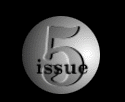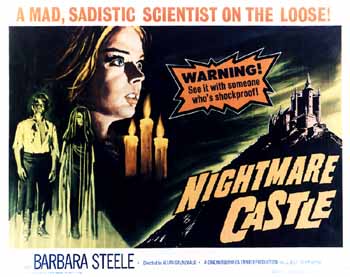|
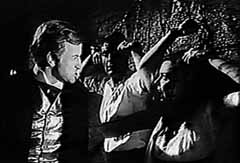
Dr. Stephen Arrowsmith (Paul Muller) tortures
his unfaithful wife, Muriel (Barbara Steele)
and her gardener-lover, David
(Rik Battaglia) in Nightmare Castle .
By its derivativeness, Nightmare Castle represents-at the height of what is now regarded as the golden age of Italian horror cinema-the decadence and decline of that cinema. Then again, the entire cycle, from its beginning, reflects the decadence and decline of the commercial cinema of America. Its rise coincides with the collapse of the Hollywood studio system, with the assumption by small independent companies (from American-International on down) of the responsibility for churning out low-budget genre movies that at the studio system's height were the province of studios such as Universal and Monogram. In addition, the Italian horror cycle reflected the erosion of censorship and good-filmmaking standards, as seen in the new genre's emphasis on blood and sex and an often aberrant visual style.
If the masterworks of Bava and Freda are extensions or perversions of the cinema of Hitchcock, Nightmare Castle must be an extension of an extension: it stretches its derivation from some kind of standard or classic model even thinner than does, say, La ragazza che sapeva troppo ("The Evil Eye," Mario Bava, 1962).2 Nightmare Castle superbly embodies the delirium of the Italian cinema with its shipwrecked, remote quality. It belongs to a cinema dreamed up by people who spent their lives watching movies and thought about nothing else. In this, Nightmare Castle and its cousins (such as Antonio Margheriti's Castle of Blood) resemble the films of the French New Wave (another trend roughly contemporaneous with the rise of the Italian horror cinema), but unlike Godard and Resnais, Caiano and Margheriti don't come off as intellectuals. They, too, play games with the filmic structures they've inherited, but not in order to create new forms or to criticize the dominance of the commercial cinema and the worldview it imposes, but to acknowledge, with abject lack of irony, the total victory of this worldview and the need to recycle its most worn-out manifestations. Caiano and Margheriti are masters of an absurd, defeated anti-cinema, devoted to the twin pursuit of a meaningless formal elegance and ever-more sophisticated forms of titillation.
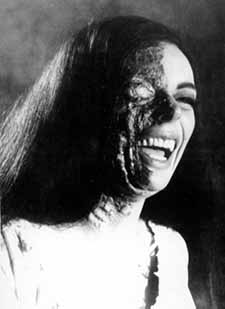
The acid-scarred face of Muriel.
In Nightmare Castle, Dr. Stephen Arrowsmith (Paul Muller) kills his unfaithful wife, Muriel (a dark-haired Barbara Steele), and her gardener-lover, David (Rik Battaglia), removes their hearts, and uses Muriel's blood to restore the youth of his devoted housekeeper, Solange (Helga Line). Stephen marries Muriel's stepsister, Jenny (Steele as a blonde), in order to gain possession of Muriel's estate, which Jenny has inherited. He and Solange scheme to drive the mentally fragile Jenny insane, while, independently of their machinations, Muriel's spirit seems to be also influencing Jenny. At the film's climax, Jenny's psychiatrist, Derek (Lawrence Clift), inadvertently brings Muriel and David back to life by removing their hearts from the dagger on which Stephen has kept them impaled. Muriel kills Stephen; Derek throws the hearts back into the fire, consigning the revived dead pair back to nonexistence, and he and Jenny flee the house.
Despite its over-burdened plot, combining pseudo-science with the supernatural, Nightmare Castle is obsessed with a small number of motifs that it abstracts from all context of plot, let alone any social, political, or even geographic context. The film takes place almost entirely in castle interiors, frequently in darkness. Although the 100-minute version of the film (titled "The Night of the Doomed") is more fluid, the abrupt cutting of the drastically shortened prints usually seen in the United States3 aptly emphasizes the repetitiveness of the narrative, which consists largely of encounters between Jenny and either Stephen or Derek, intercut with scenes in which Stephen conspires with Solange or tries in vain to interest Derek in his experiments. In scene after scene, characters inconclusively discuss Jenny's condition. Occasionally, the film lurches to some dramatic highlight as if out of generic obligation: Jenny has a dream recreating Muriel's fatal trip to the greenhouse; a butler is electrocuted while reaching into a filled bathtub. The holocaust that allows the movie to end answers no internal narrative necessity but is caused unpredictably, by accident.
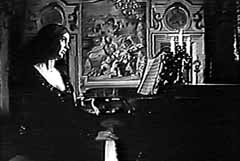
Muriel at the piano.
With his pointlessly elegant camera movements, Caiano establishes a visual style limited to external concerns and gratuitous gestures, achieving an effect that feels at the same time cloyingly aestheticized and somewhat crude. Actors move as if directed by hypnosis, their gait slow and cautious (so that the use of slow motion in the dream sequence, if noticed by the viewer, registers as pedantically redundant), their line readings funereally deliberate, as if they were algorithmically calculating their dialogue according to some abstruse mnemonic system. A typical shot sits Solange and Stephen in foreground armchairs, him reading a book (a favorite pastime of both characters throughout), her staring uncomfortably, while Jenny blunders moth-like into the deep-focus background.
Even the film's violence is depressing. The early scenes of Stephen tormenting the chained Muriel and David seem intended to embarrass rather than mortify or titillate the viewer. As played by Paul Muller (a good actor who once worked for Rossellini and later appeared in multiple Jess Franco films), Stephen seems uncommitted to his own cruelty, a dilettante sadist. Muriel's dragged-out exclamations of "No! No! No!" take us out of the world of actual suffering and into a theatrical world where overacting is a sign of art and pleasure. In the final sequence, the resurrected David is a lobotomized zombie, slowest of Caiano's slow-moving troupe, while Muriel is an acid-scarred house-of-horrors spook on a rampage of Steele-isms: in a memorable shot, she backs out of camera range, chortling compulsively, her eyes fixed on her offscreen husband, whom she has just burned alive.
One of Nightmare Castle's assets is its charming English dubbing. Although I'd like to see the Italian version of the film, it's hard to believe that an exchange like the following could be improved in any other language, unless, perhaps, it were translated by computer:
MURIEL: I'm going to rid you of your vulgar ways and replace them with others much more subtle and refined.
DAVID: I don't understand you.
MURIEL: It doesn't matter.
In Italian, one would also lose Stephen's pronouncing "hallucinogen" as "hallucin-oh-gen" and, most importantly, the credible forlornness and self-absorption that Jenny's line readings transmit (Steele dubbed her own voice in this role, I think). When her husband accuses her doctor of seeking to take advantage of her, she protests: "I've known Derek for years. He's such a good friend of mine. He's so affectionate and unselfish," stressing the words "years," "friend," "affectionate," and "unselfish" with the same plaintive intonation. Steele convinces the viewer that this is indeed how a slightly spoiled heiress (perhaps one who attended, as did Steele, London's Chelsea Art School) would sound if someone criticized her shrink.
Near the end of the film, the revived Muriel proclaims to Stephen: "But you can't destroy flesh, any more than you can love or hate. It's all the same thing." Leaving aside their possible reference to pre-Socratic philosophy (although the connection is tempting), these lines sum up the doomed world of Nightmare Castle, a world dominated by unfathomably capricious physical laws, unbelievable extremes of passion, and the unshakable awareness that time has stopped along with the narrative--"It's all the same thing." If it's not clear from the foregoing, I like Nightmare Castle. I look forward to seeing it several more times.
Chris Fujiwara is a writer, musician, and filmmaker whose articles have
appeared in Hermenaut, Tower Pulse!, and other magazines. His book on
Jacques Tourneur will be published next year by McFarland & Company.
Italian Horror Menu page
Italian Horror: A Brief Introduction
Mario Bava: The Illusion of Reality
Mario Bava's Rabid Dogs
Mario Bava Biography
The Horrible Dr. Hichcock
The Devil's Commandment 
Castle of Blood 
Nightmare Castle
The Bloody Pit of Horror 
Italian Horror in the Seventies
Suspiria
Italian Horror Web Links
Photo credits: Dean Harris, Silent Scream, and Sinister Cinema.
|
